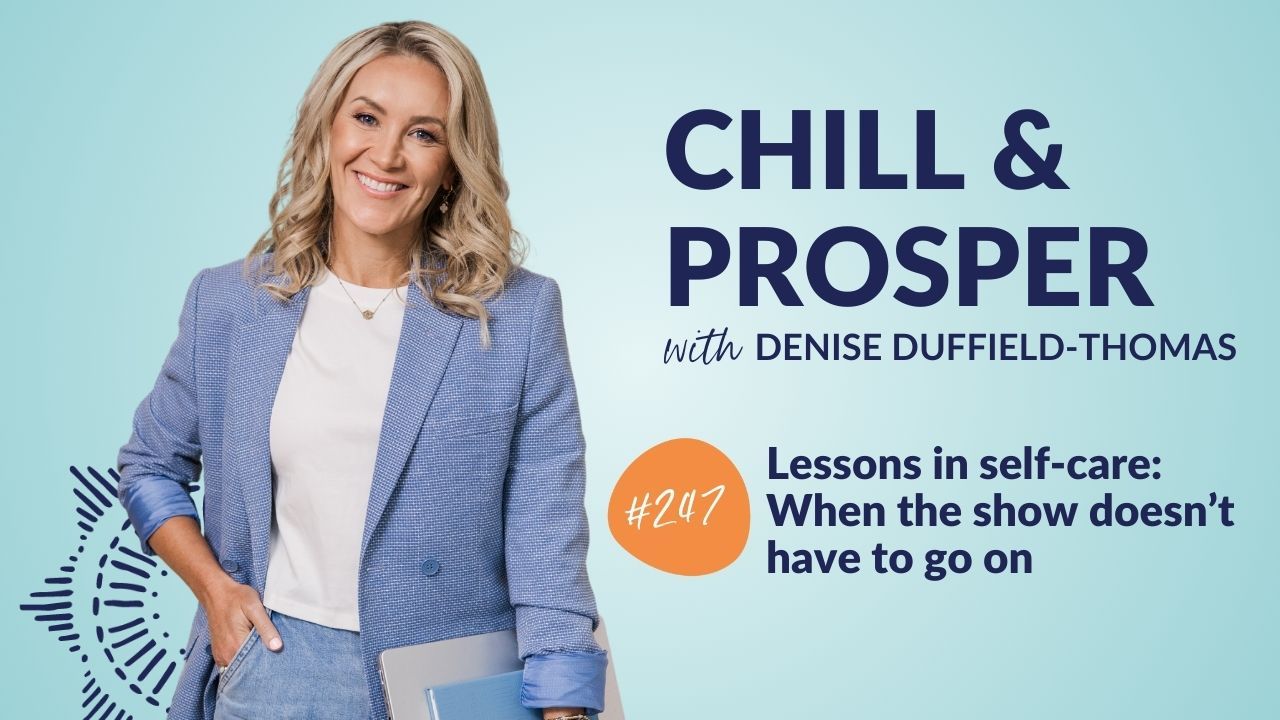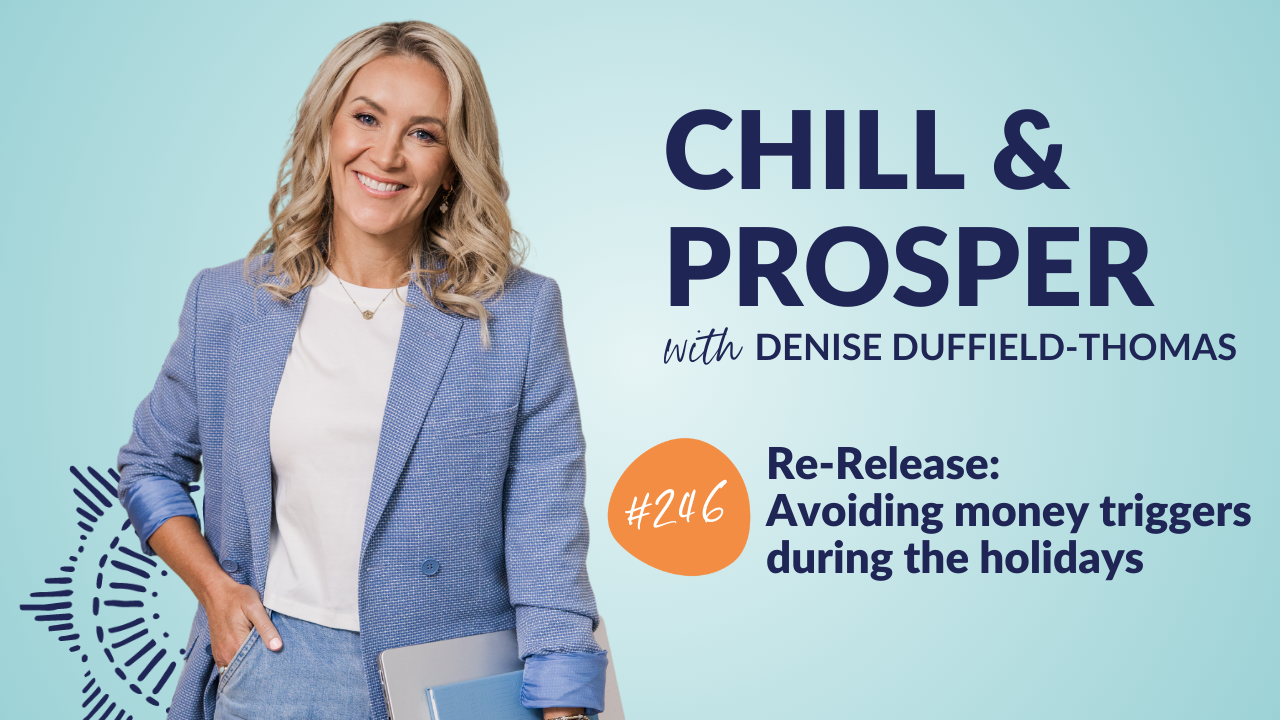Challenges & Successes From My Second Year In Business (& How I Doubled My Income)

I’m thrilled at all the comments and discussions around the first instalment of this series. It’s awesome to meet SO many entrepreneurs!
Click here if you missed it: Behind the Curtains of My First Year in Business
I’m doing this series because honestly – I love sharing stuff. I’ve always been a bit of a know it all – and I really love deconstructing success.
But first…
Let’s address the COMPARISON thing
Remember – success is completely subjective. I told you in the first post that I made 60k in my first year. Some people would be intimidated by that. Others would think “Is that all?!”
Let’s get this out of the way. In my second year, I made around $146k. You might not think that’s possible or typical, but at least I’ll be honest about how I did it.
The only reason I’m telling you this is because NOBODY EVER TALKS ABOUT IT. If you’re feeling deflated by my honesty – remember this is YOUR JOURNEY.
It doesn’t matter about the time frame. Maybe you need to hustle more. Maybe you’re in the wrong business (it’s totally ok to quit, even if you put HEAPS of time and effort into it). Maybe your time is just around the corner. Maybe it’s something practical like a branding or communications issue or you need a bigger list. Maybe you’re EXACTLY where you need to be.
I really stopped comparing myself to others, or even READING about my competition in my second year and it made a WORLD of difference.
It’s a GOOD thing to be triggered by others – I’ve often used it to fuel my fire. Remember, my journey is my journey. Yours will look completely different.
Let’s get onto my second year of business (for me, this was 2012)…
Challenges in my second year of business
I think this was my busiest, often most stressful and definitely the biggest learning curve time. Here’s what I struggled with the most:
Shiny object syndrome
Should I do this… or that?
What is the ONE THING I should do now? (hint – there isn’t usually one thing – it’s usually several things repeated several times over)
Personal development conferences took up a LOT of time and income. I travelled from Australia to the States five times in 2012, mainly because I didn’t want to miss out on an amazing conference.
Were they all amazing? Hmmm – mostly, but I spent more than $20,000 on travel and expenses alone.
(For those of you who don’t know the distance, you’re looking at a 17 hour flight just to LAX, then wait times and transfers. A typical Economy flight is between $1800-$2500)
I felt like I had to do EVERYTHING – create a mastermind, no-wait – maybe I should offer retreats…? I think I need to write another 5 books… make a zombie film (for real).
I also spent HOURS (literally hundreds of hours) and thousands of dollars in a recording studio, doing the audio versions of both my books plus a complete manifesting program. None of these have seen the light of day. Never.
I spent more than $4000 on a virtually finished book about manifesting your soul mate and decided to kill it (that was actually a great decision).
For the first part of the year, I probably spent more time being distracted by what other people were doing, or what new course I should do, than really buckling down to work. But it was FUN!!!
Spend, spend and SPEND some more
Omg, I’m making heaps of money – what should I buy?
I’m not talking about STUFF, although I bought some nicer clothes and handbags.
I spend a SHIT TONNE on courses and programs. I kind of went wild on spending – courses, conferences, coaching sessions, tools and various things that I never used.
Some was incredibly helpful (see the Investments section below), some was literally just because I had the money. I justified it because it was for my business = tax deductible.
I spent at least $25k on personal development, coaching and courses. For SURE most of it was useful, but it wasn’t necessarily the best use of my cashola!
I wasn’t putting any money away for tax (and suddenly I was paying GST too). So, even though I was earning good money, I was having major cash flow issues. My payments for my mastermind bounced more than once!
My book-keeper would say “So, you didn’t make any profit this month“, and I was thinking “Wow – I’m so clever to have spent it all – less tax to pay!” (See the problem with that?)
It wasn’t all big things – I spent $150 in one day on Fiverr. On kind of weird things, just because. I was going to do a whole video on Fiverr fails and then I got bored and thought of something else.
I spent $5 on this…
I think some of it was just getting it out of my system – wow, I finally have some CASH. Some of it was a money block – I’m earning too much – I must get rid of it quickly. I was definitely having fun, but I was creating my own FEAST and FAMINE cycles…
An entrepreneur’s work is NEVER done (work/life balance)
You that feeling when you’ve ticked off your To-Do list but you still feel vaguely naughty, like you SHOULD be doing more?
Being an entrepreneur isn’t like studying. You finish an assignment, you’re done. You hand in your project at work and you’re done.
But when you’re an entrepreneur, there is always MORE you can do.
I really suffered from that in my second year. It meant that I worked REALLY LONG HOURS – from 6am in the morning, I’d be at my desk and I’d finish around 9 at night. I worked most weekends when I could. My work-life balance really suffered – even more than my first year.
I procrastinated doing my launches, which meant I had to pull several all-nighters. I once finished a sales page at 4am, but decided to stay up because I had a US-based mastermind call at 5:30am, then I had my own teleseminar at 8am, followed by a day of back to back coaching appointments. NOT GOOD FOR YOUR BODY.
Some of this is just being in business, but honestly, I was creating the extra workload because either I was procrastinating during the day, or spent time on non-income producing activities that I thought were important.
I often got a crazy new idea and just HAD TO LAUNCH IT NOW. Lots of adrenaline and new ideas all the time.
Suddenly, I had a LOT more clients, which was great, but I felt like I had to be working ALL the time. My husband was working long hours too, so I could get away with it and I didn’t really have any friends in our town (been there a year by that point). The only people I knew were clients because I spent so much time doing events and networking!
I started dreaming about work. Not like, nightmare scenarios, but really mundane dreams like filling in spreadsheets, proof-reading articles and even coaching in my sleep. This reached a peak towards the end of the year, when I started to reduce my client load and focus on doing group programs instead of so much 1:1 coaching.
Client boundaries
The biggest boundary problem I experienced in my second year, was clients wanting to contact me all the time in between sessions or asking questions over email.
I didn’t know how to handle it or say no. They’d email, Skype and FB message me, “Hey, just a quick question“. But of course, when you have 20 regular clients, it’s a nightmare, because you can never switch off.
After stressing ALL night one time, I told a few clients. “Hey – just to let you know that unlimited support in between sessions isn’t offered in your package. You’re welcome to email me your questions, but I’ll wait and answer them in our weekly session. Oh and keep them to email rather than Skype and FB message so they can be in one place“.
OMG – I felt like the BIGGEST BITCH in the world. But it cut down on my workload, got my clients to think a bit more for themselves and to value my time more. (They weren’t going to waste their valuable coaching hour on something they could Google themselves, but were happy to ask me over Skype, especially when I kept enabling that behaviour with a 5 minute response time).
Think VERY carefully about adding unlimited email support into your coaching packages. It’s rarely worth it and teaches your clients to rely on you for EVERYTHING. I find that new coaches especially want to do this – because they think it’s being really generous for their clients, but it doesn’t always work out too well. You have to believe in the value of your face time and pad it out with unnecessary extras. If you don’t believe me, try it and see for yourself
Fear of being visible
I was starting to get a name for myself but honestly, it was kind of painful sometimes.
Most people don’t believe me, but I’m a total introvert. I love working at home by myself all day. I don’t like nightclubs or noisy restaurants and I’m really happy with a small group of friends. I would always rather sit and read a book than virtually ANYTHING else.
But I LOVE my business. I love helping other people. Just doing it so publicly could feel overwhelming at times.

Me showing off my Cleo magazine spread
I got a few traditional media interviews, but I felt really self-conscious. One part of it was feeling like a fraud – thinking that traditional media didn’t understand my business (they don’t really) and the other part was not wanting to be visible.
So paradoxically, as I was looking to increase my social media presence, it felt good from a business point of view, but hard personally. I also felt immense pressure to be this perfect, happy-go-lucky, sunny and pretty person. I was also starting to put on weight and worried about what people would think of me. Surely I have a PERFECT life?!
Nope. Sometimes I’m a grumpy bitch who nags my husband because he stacked the dishwasher wrong. (I’m not even going to put quote marks on the “wrong” – it just is). I don’t have all the answers. I get scared about my business too and wonder if I’m doing the right thing.
By the end of the year, I started feeling less self-conscious and just put more boundaries around my social media / public presence.
For example – I don’t always Instagram while I’m out. I’ll take pictures, but might post them hours or even days later. Although I’m happy to talk numbers and tell stories from my business, I only share what I’m comfortable sharing.
Fear of making mistakes
This might sound REALLY f-cking dumb, but when anyone bought anything from me, it would make me physically sick. Like, WHY WOULD YOU BUY THIS? You’re going to see all my mistakes! The weirdest thing is that I KNEW there were mistakes – like broken links on my website or things that didn’t work, but I felt completely PARALYSED to do anything about them. SO WEIRD.
I think anyone who finishes their sales page a minute before they launch, or creates their course as they go feels the same way. We think that everyone else has it all together, but guess what? I’ve even heard the same thing from MY million dollar coaches! They still sometimes do things last minute! They feel like they’re making it up too!
Who knew, right?
THINGS I DID GREAT IN MY SECOND YEAR
List building
This was a big focus. I started the year with 1826 people on my list and ended with 5275.
This made a HUGE difference to my income, especially when I started running group programs (more on that in a second)
What really worked for me (in order of results)
- Running regular free teleseminars on different topics
- Weekly blog posts (really trying to avoid writing generic content)
- Guest posts (but being REALLY picky about choosing popular blogs)
- Participating a LOT in forums (particularly, Marie Forleo’s Rich, Happy & Hot B-school and Gabby Bernstein’s Her Future)
- Doing interviews galore (sometimes with really random people)
I didn’t do ezine article marketing, any paid advertising or SEO. I only started doing Facebook advertising in my third year.
I tracked my list building numbers every month:

(By the way, this is minus unsubscribes. I go through and delete anyone who has unsubscribed each month, just to keep my list clean)
My website traffic definitely increased from the year before (again, those spikes are blog posts – SO important to be consistent with your content)
Blue line is first year of business, orange is the second year.

I increased my prices regularly
To be honest, I started pricing out some of the time-wasters because I started the year with some random clients.
In my first year, I started out at $75 a session, then increased to $97, then $149, then $249. In the second year, I went to $330 for a while, and then to $550 for a package of a one hour session and 30 minute follow up.
If you’re curious on HOW I increased my prices, I have an Ultimate Guide to Pricing that has all the scripts and psychology behind it. Access it here (it’s free)
I also offered several special packages, for 6 or 12 sessions at a discount. Every time I increased my prices, I’d lose some clients, but overall my workload remained the same.
I’d usually see about 15 clients a week in a good week. Some were on weekly packages, others on bi-weekly.
Here was a fairly typical client load for me
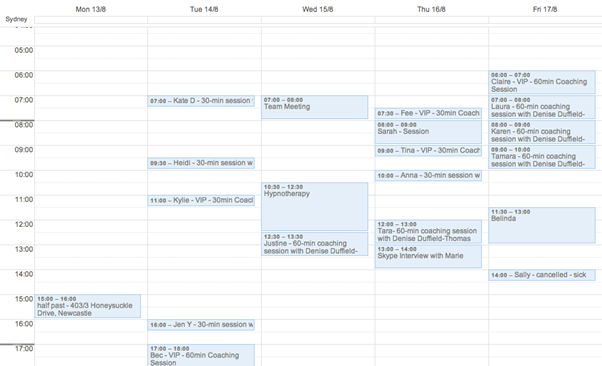
I couldn’t really do more without feeling burnt out. I’m definitely not the kind of coach who can speak to people back to back all day long.
That’s why increasing your prices as you get better is SO IMPORTANT. It means that you don’t just have to keep working harder and harder.
I also started phasing out of coaching towards the end of the year. It’s a brilliant way to make money and serve people, but honestly, I can’t handle the repetitive conversations. After two years of coaching, I got the same problems over and over again, which made me really frustrated and wasn’t good for my clients.
I also realised that I was actually better at teaching and consulting, than coaching. I just didn’t have the patience to work with people over the long haul. I knew that I wasn’t doing people any favours by continuing to offer coaching, so I stopped doing it altogether in my third year (more on that in the next instalment).
HOWEVER – don’t jump out too soon, unless you have a growing newsletter list or you’re prepared to offer something high priced enough to warrant a tiny workload. If you’re sick of coaching 1:1 – that’s cool – but come up with your back up plan.
I got REALLY picky with my clients
I started saying no to people who weren’t a great fit.
Definitely started saying no to male clients, or people who didn’t have businesses.
The male clients was a super personal thing. First, I didn’t feel like my coaching style really worked with the masculine energy. Secondly, you’re having quite intimate conversations with your coach – often telling them things that you’re not telling your friends and sometimes even your partner. I felt like it was an inappropriate “relationship” to have as a married woman. It didn’t work for ME.
Most of my regular clients, I absolutely LOVED working with, but I’d still get a few randoms, even at the $550 price point. I didn’t feel like I could really help them change their entire business in 90 minutes, but their expectations were REALLY high for the cost of the coaching and they couldn’t afford to invest in a longer term program.
I definitely got the best results with people who committed for 3-6 months, and were willing to put the work in over time. Successful businesses aren’t built in a month, and I found it stressful dealing with people with unrealistic expectations. I decided to start working with people who had already started making money – rather than people who were desperate for their first client.
Remember – you don’t have to help EVERYONE – you can choose not only the type of client, but their life stage as well. You might specialise in start-ups, or you might work best with people already earning a certain amount of money.
I also started being clearer with my hours. I took Monday off coaching (and eventually Friday as well) and instead of giving clients pick of a million different appointment times from 6am-6pm, I gave them only a few choices. (You can set this up easily using TimeTrade, a great online scheduler).
Again – something really interesting here about when you’re TOO generous. One of my clients saw that she could have a pick of roughly 40-60 time-slots and told herself “Oh, Denise mustn’t be that successful“.
So, trying to be TOO accommodating, had a negatively perceived affect, even though I had maxed out my preferred client load. Interesting, right?!
I ran regular group programs
This really kicked up my income and was mainly responsible for taking me from 60k to $146k in one year.
I knew I didn’t want to take on more 1:1 clients because my workload was enough for me and I didn’t feel like I wanted to increase my prices from $550 to the next price point. It didn’t feel energetically “right”.
I told you that in my first year, I ran the Inspired Life Formula course – a kind of generic “improve your life” course.
In my second year, I started running a few different ones. The least successful was my “Manifest Your Soul Mate” course in May, which I think had 14 women on it (it was really cheap, maybe $97).
Remember, the shiny object syndrome. I WAS NOT AN EXPERT ON SOUL MATES. I wasn’t even particularly interested in the conversation, but I thought it would be a good idea. Total distraction!
In July, I also created a cheap product, a $50 video course, which also included a copy of my book, Lucky Bitch. This was always intended as a placeholder product for something better along the track, but it was nice extra income. It was a no brainer price and it paid for some of my regular business expenses. Over the year, it amounted to $3750. Not bad for a “place-holder” program that I never really advertised much. I just put it on my thank you pages for my freebies.

LESSON: Don’t wait to put together a program – do it quickly!
The most successful was my “Lucky Bitch Money Bootcamp“. It sold for $1,000 for a six week live course, and I offered a $750 “early bird” rate. The first few times, the videos were done at home, on my iPad and me in my PJs. It still sold well, but in September, I upgraded to a video day to make them more professional. (I’ll probably update and re-record that course every two years to keep it looking good).
Over that year, I sold 128, mostly all at the early bird rate. I had a handful of refunds, not very many, but I was TERRIBLE at chasing people whose payment plans defaulted. I really had to start putting together some more sophisticated policies but I was “too busy”.
In my third year of business, I made this a home study course because after running it live four times, I got bored answering the same questions over again and realised that I didn’t NEED to do it like that to give people the benefit of the course. I had to get over a bit of guilt and a feeling of “this is too easy” to be able to do that (more on that in a future post).
Here’s the interesting thing… (and why it’s SO important to grow your list)
Each time I ran the program, I had approximately 1% or less of my entire list sign up to do the course. Let’s take a look at the numbers….

I definitely improved my sales page between May and August, but I still only sold it to 1.21% of my entire list. I also got better at sending out emails promoting the courses. I sent WAY more than I was comfortable with, and realised that most people wait for the deadline to sign up, but you get scared to send a reminder email (or two), they’ll never remember to sign up.
I see people get discouraged about not filling their programs, when literally the numbers don’t work out.
It doesn’t mean that it’s not good. That doesn’t mean you CAN’T sell a program with a small list size, it just means that you’ll have to do more high-touch marketing, for example, getting people on the phone and selling them 1:1 – and that’s only worth it for a high end program.
I starting saying NO THANK YOU to random stuff
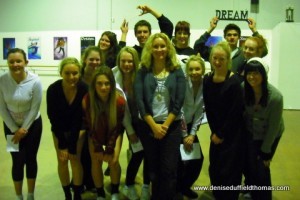
Speaking at my old dance school!
At the beginning of the year, I started to get some really weird speaking requests – like government team days, charity events, even my old High School.
I spoke at the local University on networking, the local business club about writing a book and even did motivational gigs as a favour to my awesome dance teacher, talking about personal development for the dancers. “Denise, is that you on the trophy wall who won ‘Best Dancer’ in 1992? I wasn’t even BORN yet“.
It was awesome for my ego to get paid for speaking, even the free ones were exciting. Telling people I had a speaking gig just felt SO COOL! I felt like I was a serious business lady.
By the way – if you’re ever unsure about what to charge for speaking – just simply ask what their budget is. They’d say “Our budget is around $500” and I’d say “Well, that’s a happy coincidence because that’s exactly my speaking fee!“. (You say that no matter what figure they mention)
After a while, the novelty of speaking wore off, especially since I felt like I had to constantly mould myself to a different topic every week.
Could you speak about time management? SURE I CAN.
Could you come and speak at my real estate office? NO PROBLEMO.
Can you talk to our students why they should study harder? I DON’T SEE WHY THE F-CK NOT?
I actually started saying NO, just to see what it felt like.
Then I’d say “You know what, that’s not really my speciality – can I recommend someone for you?”.
Do you know how HARD it was admitting that I wasn’t good at something? (Especially for a Virgo?!) I was used to being the Jill of All Trades – and if I had to stay up all night researching a topic, I would do it. Because I was getting involved in so many corporate clients, I also started feeling like I couldn’t really be myself. I couldn’t swear and be silly. I had to dress up reasonably nicely and be on my best behaviour.
Boring.
So, I started saying NO to every request that wasn’t in my zone of genius. I actually even started saying no to speaking gigs in my town. I figured that I could find clients online, I didn’t need to sh-t where I slept (so to speak). It also felt nice having my town as my home, instead of my place of business.
The lesson really – is that business gets so much better when you do the things you like. Your business, your choice.
BUSINESS INVESTMENTS I MADE IN MY SECOND YEAR
I already mentioned, that I spent a SH-T tonne of money on courses, travel for conferences and personal development.
To be honest, I joined a mastermind that probably wasn’t the best investment at the time. Again, it required quarterly travel to the States (effectively doubling the cost of the mastermind itself), the calls were at an ungodly hour for my timezone and it wasn’t the best cultural fit. That was probably a $25k investment that wasn’t the best (not totally worthless, because I DEFINITELY got new insights, it just wasn’t really what I needed for the year).
Staff / Contractors
One thing I realised about myself in my second year is that I’m a total introvert who likes to work largely by myself.
I HATE MANAGING PEOPLE. Always have. All of my jobs have been largely individual. I never liked working with others… no wonder then that I struggled to work with employees!
I went the Indian V.A route and it really didn’t work out. I had two different people working for me part time each, for about $1200 a month. But I just wasn’t ready to have two part time staff and I found myself giving them really random instructions, because I didn’t know what else to give them and also the language barrier was sometimes a problem. I’d be like “um, can you find me 200 quotes on finding your soul mate” but the result would be kind of random and not the voice I was looking for.
My best staffing hire was towards the end of the year when I worked with an Online Business Manager, who helped me systemise processes. She basically got me organised, helped me prioritise projects when I said I was going to launch 5 things in one month and was a valuable sounding board to help me when I was having a challenging week.
Other things I contracted out: graphic design, recording and editing audio, a video day re-recording my money bootcamp, (with a guy who also edited them) and a book project manager (more on that in a sec). I also changed accountants from using one of my best friends to a local guy who came recommended from a business friend.
I don’t think I’ll ever be someone with a large full time team. I really like to streamline and hire people when I need them. I always prefer contractors over full time staff.
Went PRO in some of my systems
I moved from 1ShoppingCart to Infusionsoft to deal with my newsletters and opt-ins. It was a big learning curve, but it was a great time to do it.
Started using DropBox to back up all my files (it sounds like a small thing, but losing data is a bitch).
My website was still on Typepad and I was tempted to move over to WordPress several times but it felt like too big a project (I ended up changing over in my third year – should have done it sooner).
Good photos
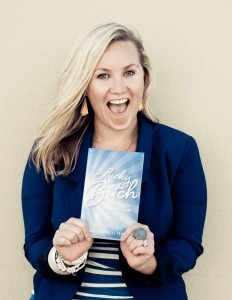
This makes SUCH a difference. Truly, you can get away with crappy branding if you have good pictures. That’s all anyone will notice.
In my opinion, good photos will be more useful to your business than a logo (I STILL don’t have a logo!). It also has a crazy effect that people think you’re more credible and well-put together.
Seriously, this is a good investment. I didn’t spend thousands, I spent a couple of hundred bucks and it was so much better than I was using before. I noticed a big leap in my income and confidence from having them, because even if I was working at home wearing no bra, people had a good public impression of me
I ended up with several hundred really good pics, that I’ve used over and over again. I only wish that I’d changed clothes a few more times in my session. I got super lazy, so I’m just wearing the same thing in virtually every picture.
Oh well, it’s good consistency! By the way – have you ever noticed why I post SO many pictures of myself all over my website? It’s a brainwashing thing…
Made a HUGE lifestyle upgrade
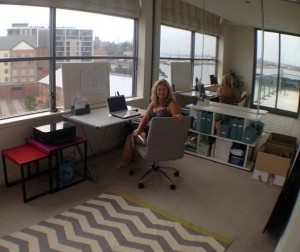
This became my new office view.
One of the BEST things I did in my second year of business was to drastically increase our standard of living. We were still living in a small apartment, even though we both had six figure incomes. Mainly because I was stressing about how to afford a big house deposit and how to get a mortgage considering that we were both new to the country (I am Australian but spent all of my twenties living in London).
I was reading a book by Chris Guillebeau and he said “You don’t have to live your life the way other people expect you to.”
He also spoke about how he rents instead of being locked into a mortgage. It was like a light went on in my head.
I turned to Mark and said – “Let’s rent somewhere SPECTACULAR!”
Literally, within the next six weeks, we were living in a waterside penthouse apartment. That moved made a HUGE increase in my income. I felt WAY more abundant with my life and the energy trickled down to my clients. I had MORE people who wanted to work with me.
I remember we were looking around the new apartment with the estate agent. Mark was looking at me, mouthing “Don’t even THINK about it”. But we did the numbers and it was doable. I just knew how many more coaching clients I needed, which made me hugely more motivated in my business.
Seriously – I know this isn’t a BUSINESS investment because it was a personal cost, but it completely upgraded my business too.
Invested in writing a second book!

This was the BEST investment I made all year. But not for the reason you think…
Books in general aren’t the best source of income. For me in my second year of business, it was worth almost $4000 in income. This is pretty typical for an author, (self-published or not) unless it’s a runaway success.
Books are a business card and a marketing tool. They give you credibility. They get you speaking gigs. They introduce your work to a new audience. But you need to have a money making strategy off the back end of your book. Ie. People buy your book, they come to your website to get an exclusive freebie, you nurture them and build a relationship, and then they’ll become a client in another (more lucrative) way.
Here’s how much I made from selling my book on Amazon, iBooks, Barnes & Noble (online) and the Diesel e-reader store. Kindle was the most popular, followed by paperback on Amazon – honestly the rest were negligible and not worth the effort.
I make on average, about $4 per book.
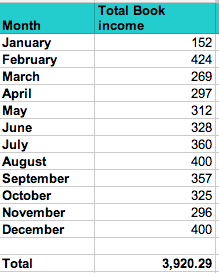
Not exactly a full time income, is it? Yes, it all adds to the pot, but that’s the point – you need other things in the pot to make good money.
You will find this though – to your friends and family, your book IS your business. So they’ll ask you “How’s your book going?“, when it fact, it’s just a tiny marketing strategy out of the whole mix.
It kind of deflates them when you say, “Well, I only make a few hundred a month out of my book, but I made $10,000 last month on my info product!“. They just don’t understand, so it’s easier to say “Great. The book is doing great!”.
The second book….
Was done VERY differently to my first one. This is my book about money – Get Rich, Lucky Bitch!
I wanted to write a second book, because I knew that I wanted to shift my focus exclusively to money and wanted a low cost entry point into working with me. But I was procrastinating.
The first one, I sat down and wrote it like a college assignment – stressed and last minute. I obsessed over the word count and it really was a HUGE pain.
This time, I partnered with a local editor and book writing team. I sent them about 500 pages of transcripts from when I first ran the money bootcamp, and they trimmed and edited it down to about 180 pages. I then went through it, added additional stories and material (about 40 pages extra), and then sent it back to them for a final proof read. SO MUCH EASIER than starting from scratch.
Between the book editing team, the cover, the formatting, etc – the book cost me about $6000 to produce.
Here’s though where it’s SO important to have a marketing plan for your book. I knew that I’d only need to sell 6 full price money bootcamps to break even.
Even though the book was essentially finished at the end of my second year in business, I then actually launched this in my third year – because predictably, I got distracted on something else! (More on that in the third instalment.)
I was thinking that I could write a few books every year but to be honest, it’s a BIG project. One or two books is enough for credibility and to get your name out there. Focus the rest of your energy on getting clients, creating info products or group coaching programs.
Where did my income come from?
The majority of my income came from my Money Bootcamp, followed by private coaching, then affiliate income and then a random assortment of book and speaking income.
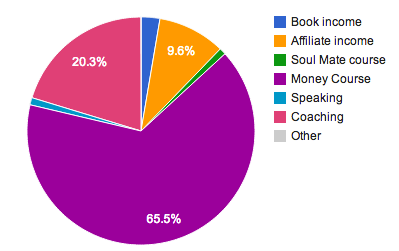
And this is how it played out throughout the year… most of the income came in the last few months – this is where I started running regular group programs.
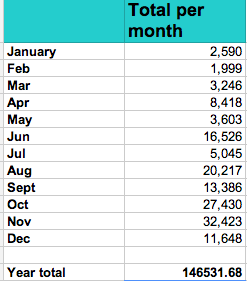
(These are the running totals that I kept throughout the year – my “official” figures from my book-keeper might look a bit different, but it’s a good rough estimate)
The affiliate income came mostly from promoting Marie Forleo’s, Rich, Happy & Hot B-School which was a $1000 commission. Because that experience was so good, I realised that it probably takes just as much work to make $1000 commission as it does to make $5 promoting someone’s ebook. So it’s a business decision for me now to be REALLY picky about who I promote as an affiliate. It has to be a great fit and it has to be worth it. Otherwise, I’d just rather promote something I believe in, without bothering with the commission.
So in summary…
My second year in business was one of MAJOR turning points. A lot of experimentation, sometimes a frenzy of random activity, but that’s pretty normal. It was a thrill to be making six figures in my second year, but honestly, try not to spend it all like I did
It’s okay to try things and then realise that it doesn’t work. It’s okay to quit things, even if you spent time and money on them.
Boundaries with clients will make your life SO much easier (and they won’t think you’re a bitch)
Create your first info product (even if it’s a small thing, like my $50 course), it makes the transition easier if you decide that 1:1 service isn’t for you and gives you some leverage.
Try and hire your first employee. It’s a great learning curve and you’ll get the hang of it eventually.
Keep hustling, keep trying and DON’T GIVE UP.
Being in business for myself has been better than I ever imagined. It’s literally a dream come true to get up every day and choose how I’ll change the world.
It’s there waiting for you and you can do it too!
xx
Denise
FREE MONEY MINDSET TRAINING
The 7 Most Common Money Blocks and How to
Clear Them
Discover which blocks are keeping you under-charging, over-delivering and from earning what you're worth!
Register now for instant access



